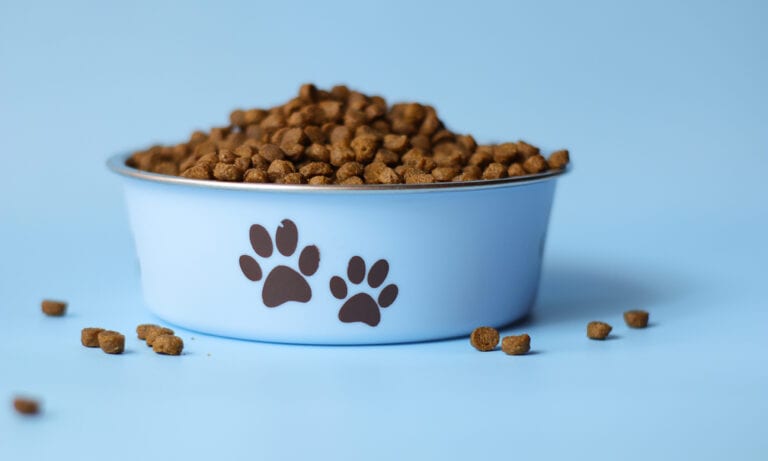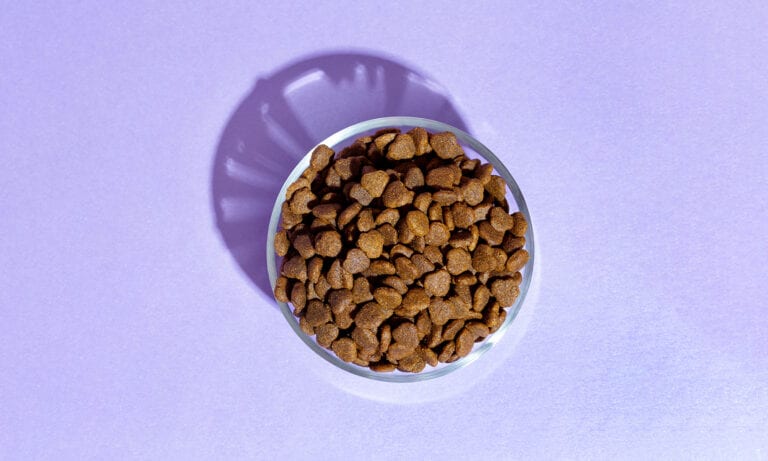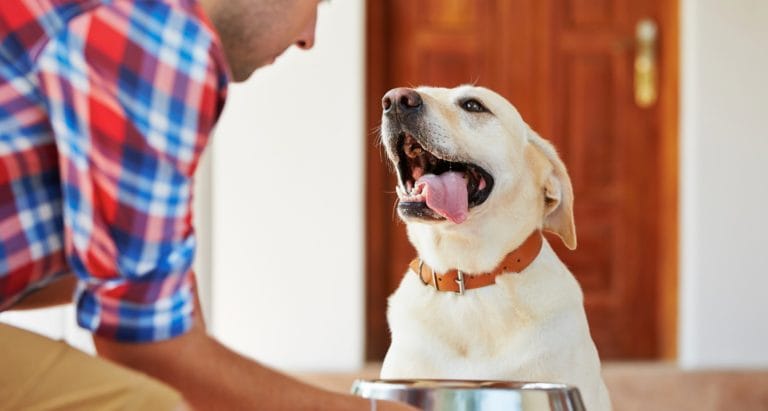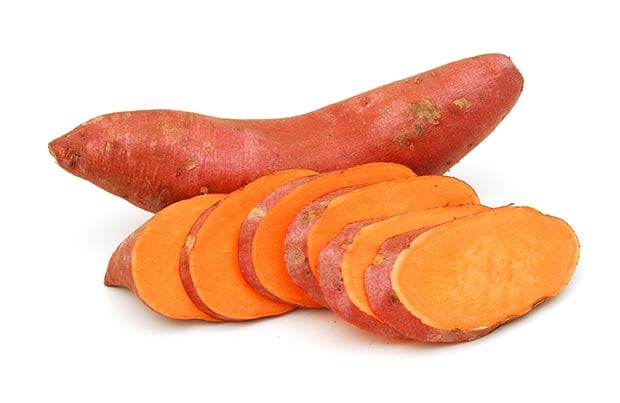Pet parents want the very best for their four-legged besties, including long, happy and healthy lives. The key to that is feeding them a complete, balanced and nutritious diet. But what if the diet isn’t working? Read on to learn more about raw diets for dogs to see if this might be an option for your pet in consultation with your own vet.
What Exactly Is a Raw Diet for Dogs?
So, what is a raw food diet for dogs? Most people really mean a raw meat diet.
“Typically, it consists of a raw meat or protein base,” Lindsey E. Bullen, DVM, DACVN, at Veterinary Specialty Hospital of the Carolinas in Cary, North Carolina, says. “Anything from home-cooked to commercial—including kibble, chubs and freeze-dried. There’s a lot of different types and forms, but typically it means uncooked.”
Besides the meat/protein, she says they often include a carbohydrate—such as grain, sweet potato, peas or lentil—and a fat source, such as oil, chicken skin or liver.
Homemade raw food diets for dogs “usually are primarily raw meat, sometimes with vegetables,” says Joseph Bartges, DVM, Ph.D., DACVIM, DACVN, professor of medicine and nutrition in the department of small animal medicine and surgery at the University of Georgia College of Veterinary Medicine in Athens, Georgia.
Creating a balanced raw diet for dogs at home using whole foods is difficult to do, says Lisa Weeth, DVM, DACVN, founder of Weeth Nutrition Services and a veterinarian in the nutrition department of Metropolitan Animal Specialty Hospital in Los Angeles, California, says
“It takes about 20 ingredients, no substitutes or rotating, etc. I haven’t found any home-prepared [raw food] diet [for dogs] that owners found out of a book or another resource that has provided all the nutrient needs.”
Commercial raw diets tend to be more complete and balanced, Dr. Bartges says.
“With commercial diets, they must meet or exceed AAFCO [Association of American Feed Control Officials] requirements, and we are seeing more and more that have been through feeding trials to substantiate the nutritional adequacy in addition to the chemical analysis of the food,” he says. “With homemade diets, it is unknown unless evaluated by a board-certified veterinary nutritionist.”
Some board-certified veterinary nutritionists will work directly with your vet or with you on nutritional consults. You can find them at the American College of Veterinary Nutrition’s website.
Learn more about types of dog food diets.
The Benefits of Raw Dog Food
Feeding pets a raw diet isn’t a new concept. However, the heightened popularity is new.
“One of the first canned foods was raw horse meat over a hundred years ago,” Dr. Bartges says. “This had some health issues, though, and didn’t last long.”
Enter the BARF diet in the 1990s, courtesy of Ian Billinghurst, B.Sc.Agr. (agronomist and nutritionist), B.V.Sc.Hons (veterinary science) from Australia. His BARF diet acronym stands for Bones And Raw Food, or Biologically Appropriate Raw Food.
Dr. Billinghurst’s suggestion is that our pet dogs will thrive on an evolutionary diet based on what canines ate prior to domestication. That being raw, meaty bones and veggies.
Recently, as more people seek products and lifestyles that are considered to be more “natural” or “homemade,” pet parents are looking for similar attributes in products for their dogs.
To do the best for your fur family, it’s important to know the facts. Nutritionally speaking, complete and balanced raw dog food is no different than complete and balanced traditional dog food.
“When we look at the actual nutritional differences of raw versus cooked versus the exact same combinations in kibble, there is no difference,” Dr. Weeth says. “If you make a complete and balanced raw diet, the only difference is digestibility. Raw isn’t better or worse.”
Digestibility basically is “food in versus what comes out in poop,” Dr. Weeth adds. As was the case with Caesar, some animals need a more digestible diet to manage chronic disease.
Because no published scientific studies show raw dog food diets to be superior or inferior to cooked diets, veterinary nutrition experts say the benefits are anecdotal and depend on the diet’s nutrient profile and the individual pet’s needs. According to Dr. Bartges, Dr. Bullen and Dr. Weeth, these benefits might include:
- More digestible, so less poop
- Higher protein
- More energy dense
- Less shedding
- Shiny coat
- Better dental health
It’s important to note that the FDA Center for Veterinary Medicine (CVM) reports concern for public health when it comes to feeding raw dog food as it may carry harmful bacteria, like salmonella. So you’ll need to take special precautions to avoid cross contamination and infecting yourself and other members in the household. (More on that below)
The Best Raw Dog Food
Choice is a beautiful thing, and we have so much more of that in the raw dog food section these days. From making fresh raw diets at home to purchasing pre-made frozen or freeze-dried meals, there are plenty of options to fit our pooches’ needs and our lifestyles.
Fresh Raw Dog Food
If you enjoy preparing homemade meals for your family and you don’t mind the extra time and safety precautions, you can delve into making a fresh raw food diet for dogs at home using raw ingredients.
When choosing this route, you get to control what goes into your fur baby’s food and where you purchase those ingredients. Also, food from the “fridge is hopefully fresher, so theoretically there’s less time for bacterial contamination,” Dr. Bullen says.
With that ingredient control, however, comes much responsibility. Your dog’s diet needs to be complete and balanced to avoid health problems.
“If they’re doing it at home, they need to work with someone with expertise in nutrition and animal physiology,” Dr. Weeth urges.
There also are heightened safety concerns for your pet and the public.
“If truly fresh—e.g. homemade diets where you buy chicken at the grocery store—the major issues are the nutritional adequacy, if not evaluated, and infectious disease,” Dr. Bartges explains. “The requirements for pet food concerning salmonella are zero-tolerance, and this is more stringent than for human food where chicken purchased at the grocery store can contain salmonella. Therefore, feeding store-bought or butcher-bought fresh meat may result in either the dog becoming sick or the dog contaminating the environment by passing potentially pathogenic bacteria in their stool from the food.”
Also note the American Veterinary Medical Association’s (AVMA) position on raw dog food: “AVMA discourages the feeding to cats and dogs of any animal-source protein that has not first been subjected to a process to eliminate pathogens because of the risk of illness to cats and dogs, as well as humans.”
Because of the very real public health concerns, Dr. Bullen urges pet parents who are determined to feed a homemade raw food diet for dogs to use fresh, whole meat and sear the outside.
“Literally freshly killed/butchered meat is often safer to use than a store-bought meat,” she explains. “When killed in a facility there is processing and transport, and things happen during the process so you’re trusting the companies with this.
“With store-bought meat, choose whole meat over ground because if there’s bacterial contamination in some it can end up ground together, exposing it to all the meat,” she continues. “Searing the outside to feed it rare is a better idea than feeding raw to reduce the possibility of food-borne pathogens.”
To figure out how much raw dog food to feed your pooch, you’ll need to work with a board-certified veterinary nutritionist for recommendations.
“It depends on the whole diet and the energy content of the diet,” Dr. Bartges says. “It would take knowing what the nutritional composition of the foods are and determining the amount from that as well as what the estimated calorie (energy) requirements of the dog may be.”
While he is OK with pet parents feeding a raw diet for dogs, Dr. Bartges does not recommend feeding homemade raw dog food during a pet’s growth stage or if there are people in the house where exposure to an infectious bacteria, such as salmonella, could be a problem. These would include children, people who are pregnant or elderly, or immunocompromised individuals.
Frozen Raw Dog Food
If making your own raw dog food sounds unappealing or simply is not convenient for your lifestyle, many companies offer packaged, frozen raw food diets for dogs that you can store in your freezer and thaw before serving to your pet.
Feeding a frozen raw dog food like Instinct by Nature’s Variety likely means fewer trips to the grocery store because you can store it in the freezer for added convenience. And again, they must meet or exceed AAFCO regulations.
“Commercial raw diets must meet or exceed AAFCO nutrient profiles for one or more life stages for a dog,” Dr. Bartges says. “Therefore, they can be very similar in nutrient profile [as traditional diets], for example, the amount of protein, but the ingredients are not heat-processed.”
That said, because freezing does not actually kill bacteria, many raw dog food companies are using other processing methods—such as high-pressure processing, which can rid products of bacteria without using heat—because of AAFCO’s requirement for zero salmonella, he adds.
“Freezing and thawing can be an issue if using fresh raw meat, as the bacteria can proliferate during the thaw phase,” he says. “If left out too long, the meat can become spoiled as well.”
For help choosing the best frozen raw dog food diet for your pup, enlist your veterinarian or a certified veterinary nutritionist.
“Your vet would be the first resource, helping you determine what food is most appropriate for your pet’s life stage, or by pointing you to someone who can help,” Dr. Bullen says.
Also, do your homework. “Look at the individual companies and what their safety processes are,” Dr. Weeth says.
To make sure you’re feeding the appropriate amount of frozen raw dog food, experts recommend talking with your vet and looking at the food package itself.
“If it’s a complete and balanced diet, hopefully the company provides a feeding recommendation,” Dr. Bullen says. “But check with your vet because every pet is an individual and the calories can be over- or underestimated on the package. My other suggestion is to start with the minimum amount recommended and adjust depending on your pet’s weight changes.”
Similar to a homemade raw food diet for dogs, Dr. Bartges recommends not feeding a frozen raw diet for dogs during a pet’s growth stage or if there are household members who are pregnant, children, elderly or immunocompromised.
Shelf-Stable Raw Dog Food
If freezer space is at a premium in your home, or you don’t want to deal with defrosting food for your pooch, there are packaged, shelf-stable raw dog foods to choose from. These are available in several forms, including:
- Freeze-dried
- Raw-boosted kibble
- Mixers
You still get the raw meat for dogs option, but these offer preservatives and a drying process to prevent mold and bacteria growth.
“Freeze-dried foods are processed by taking water out so bacteria won’t grow,” Dr. Weeth says. “This is true for new introductions of bacteria, but it will not kill current bacteria already in the food.”
Unfortunately, that still leaves opportunities for food-borne pathogen and contamination, Dr. Bullen says.
“High pressure pasteurization (HPP) has been shown to kill some,” she adds, “so that’s a method to make the product safer.”
Several raw dog food brands use HPP as a food safety process, including Stella & Chewy’s, whose freeze-dried options include Duck Duck Goose Dinner Patties Freeze-Dried Raw Dog Food, with 95 percent cage-free poultry, and Lil' Bites Chicken Little Recipe Small Breed Freeze-Dried Raw Dog Food, formulated especially for small-breed dogs. Merrick Backcountry Raw Infused Great Plains Red Recipe, a kibble with raw pieces, offers a protein-focused diet, with deboned beef as the first ingredient, and also incorporates lamb and rabbit into the mix. And Primal’s Freeze-Dried Nuggets come in over a dozen varieties, including unique options like Quail Formula and Turkey & Sardine Formula.
As with frozen raw food diets, Dr. Bullen recommends choosing products “from a reputable company that has a nutritionist on staff, follows good manufacturing practices, performs post-production analysis for nutrients and microbial antigens and is appropriate for the pet’s life stage.”
And as with the other types of raw foods, check with your vet and the manufacturer’s feeding recommendations to figure out the appropriate amount to offer your dog each day.
Raw Dog Food Recipes
Because each dog has unique needs and there are various life stages, no raw dog food recipe is one-size fits all. This is where working with a veterinary nutritionist is incredibly helpful and safest.
According to Dr. Bullen, every homemade diet would have:
- A protein source
- A carb source, such as rice or potato
- Plus or minus a veggie, such as green beans or carrots
- A fatty acid (usually an oil like canola
- Mineral or vitamin supplements
“I let clients pick ingredients and then guide them toward or away from certain ones based on what’s going on with their pets,” Dr. Bullen says.
For example, Dr. Bullen would recommend store-bought whole meat like a flank steak, rather than ground beef, because she says flank steak is proven to be safer. If there's bacterial contamination in the meat before it's ground together, that bacteria is exposed to the entire meat, she explains.
She also recommends no bones.
“Though they provide calcium and phosphorous, there's opportunity for GI tract obstruction or perforation,” she says. “When using ground bones, there's risk of introducing bacteria and you're not eliminating the risk of perforation because grinding can create sharp edges."
Again, no diet is right for all dogs, so work with a veterinary nutritionist to make sure your pets get everything they need.
Keep Safety in Mind When Feeding Raw Dog Food Diets
A serious concern, specifically of a homemade raw diet for dogs, is nutritional imbalance. When it’s not formulated by someone who knows what they’re doing, the nutritional imbalance can be life-threatening, Dr. Bullen says.
Another concern is operating under fallacy or outdated information, like believing that your Yorkie is a wolf in disguise.
“Some people believe that dogs are domesticated wolves, and since they don’t cook their meat, we shouldn’t feed our dogs cooked meat either,” Dr. Weeth says. “Science shows that dogs are their own species with a different digestive physiology.”
While there are lots of similarities between dogs and wolves, Dr. Bullen says they are not so similar that we should be feeding our pets a diet for wolves.
“Their GI tracts are different, their concentration of enzymes is different, the beneficial bacteria in their GI tracts also will be different,” she says.
The greatest concern about raw dog food diets is the public health risk, veterinary nutritionists agree.
To protect yourself and others, good hygiene is crucial, whether you are making your own raw diet for dogs or handling a commercial one. As Dr. Bullen points out, “shelf, frozen, fresh, is still raw, so any safety practices you use when cooking with chicken, steak or pork for yourself, do the same with raw dog food.”
Always wash your hands before and after handling raw meat for dogs and raw pet food. And take steps to avoid cross contamination.
Dr. Bartges offers these important practices:
- Use different utensils with raw foods than for human food
- Keep raw ingredients and diets away from human food; for example, have a separate freezer for pet vs human food
- Wash utensils and food bowls separately from human-used utensils, plates, etc.
- If you must share a common refrigerator, place the raw dog food on the bottom shelf to minimize the risk of contamination
- Wear gloves
Dr. Bullen adds:
- No kisses on the mouth—your pet doesn’t have to show signs of illness to be shedding the bacteria and can still make someone else sick.
- Wash bowls daily on high-heat dishwasher setting
- Clean up counter space after working with raw dog food and decontaminate it using something like bleach that has antimicrobial/bactericidal properties
Frequently Asked Questions
Q:
Can dogs eat raw meat?
A: “Absolutely,” Dr. Bartges says, dogs can eat raw meat.
Q:
Can dogs eat raw chicken?
A: Technically, dogs can eat raw chicken, Dr. Bullen says, “But I don’t recommend it, especially with the risk of salmonella.”
Q:
Where can I buy raw dog food?
A:
“Commercial raw diets are readily accessible at stores and online,” Dr. Bartges says.
Dr. Bullen adds that while many pet stores might carry raw dog food, the people selling the diets might not have adequate nutritional backgrounds to be making recommendations for an individual dog’s needs.
“I caution clients from taking nutritional advice from someone who doesn’t have advanced nutritional training like a veterinarian,” she says. “A nutritional enthusiast isn’t the same thing.”
Q:
How do I switch my dog to a new diet?
A:
Make the change gradually to avoid upsetting your dog’s stomach, Dr. Bartges says: “Transitioning over a week or so by slowly increasing the amount of raw diet while slowly decreasing the amount of the old diet is how I would approach it.”
Dr. Bartges suggests a ratio of ¼ raw food to ¾ old diet for the first two days, then moving to half and half for two days, then ¾ raw and ¼ old diet for two days before moving to 100 percent raw food. “But it may need to go more slowly depending on how well tolerated” the food is by your dog, he says.
As always, before switching to any new pet food, talk to your vet.
Q:
How much raw dog food should I feed my dog?
A:
There isn’t a one-size-fits-all answer for this. Experts recommend working with your veterinarian, who knows your unique dog, the appropriate life stage and other applicable health needs or concerns. With a commercial raw diet for dogs, you can look on the packaging for suggestions as well.
For some dogs, feeding a raw food diet might be beneficial. But we must use care to ensure the health of our canine companions as well as the safety of others. Working closely with your vet as well as with a board-certified veterinary nutritionist will help ensure you’re receiving accurate information and guidance in the right direction to provide your precious pet with a long, happy and healthy life.
Share:



















